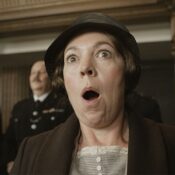It wasn’t quite a Christmas miracle, but it was totally unexpected. Take one radio humorist with Playboy credentials, pair him with a film director who made a crown jewel of the slasher movie, and then watch as the end result becomes . . . one of the most beloved family holiday films ever made? Sit back with your Ovaltine and Little Orphan Annie Secret Society Decoder Pin as we tell the tale of A Christmas Story.
It all started with Jean Shepherd. Shepherd grew up in Hammond, Indiana, earned his amateur radio license by age 16, and took classes at Indiana University. During World War II, he served in the U.S. Army Signal Corps; after his service, he began to work in radio in 1945. After bouncing around for various gigs in the Midwest for several years, he took a job at New York City’s WOR in 1955. Shepherd began to use his overnight slot in innovative ways, ranging from reading stories and poems to telling his own stories and executing comedic stunts that involved the listening audience.
Jean Shepherd reads from “A Christmas Story” (Uploaded to YouTube by The Jean Shepherd Show)
With some advice from the poet Shel Silverstein, Shepherd began turning his humor, particularly stories based on his childhood, into prose. That work got into the widely-read magazine run by Silverstein’s good friend, Hugh Hefner: Playboy. Shepherd’s first two collections were published in 1966 and 1971, respectively. In God We Trust: All Others Pay Cash and Wanda Hickey’s Night of Golden Memories: And Other Disasters contained the shorts that would provide the foundation for A Christmas Story.
Filmmaker Bob Clark had first heard one of Shepherd’s stories, “Flick’s Tongue,” on the radio in the late ’60s. He long held the notion of getting Shepherd’s work onto the screen, but his career took him in other directions first. Clark attended college on a football scholarship (he was a quarterback), but passed up a shot at the pros to go to the University of Miami for theater. In 1967, he made the film She-Man, which examined cross-dressing way before the mainstream was ready for it. After that, he made a detour into horror, including 1972’s Children Shouldn’t Play with Dead Things.
Trailer for Black Christmas (1974) (Uploaded to YouTube by Scream Factory TV)
In 1974, Clark made his first legitimate classic. Working off of a screenplay by Roy Moore, Clark directed Black Christmas, an early entrant in what would come to be called the slasher subgenre of horror. Detailing the terrifying events that occur in a sorority house around the holiday, Black Christmas exerted a major influence on John Carpenter, who would only four years later make Halloween. Though the initial reviews of the film were split, over time it’s become widely recognized as a well-made, breakthrough horror picture, and roundly praised for its cast, which included Olivia Hussey, Margot Kidder, Andrea Martin, and John Saxon.
From there, Clark really began to diversify his resume. He produced Moonrunners, which would be reworked for TV as The Dukes of Hazzard (Clark would also direct a first-season episode). He indulged in action (Breaking Point), mystery (Murder By Decree), and comedic drama (Tribute). In 1981, he scored a massive hit by writing and directing the teen sex comedy Porky’s, which earned over $160 million on a budget of roughly $5 million. He directed the obligatory sequel, Porky’s II: The Next Day, but declined the third film when he was finally able to collaborate with Shepherd. Clark, Shepherd, and Leigh Brown worked together to write the screenplay of what would become A Christmas Story.
Trailer for A Christmas Story (Uploaded to YouTube by Rotten Tomatoes Classic Trailers)
Clark gave some thought to casting Jack Nicholson as “The Old Man,” but the role eventually went to Darren McGavin. McGavin had an extensive career on Broadway and in television and film; at the time, he was likely best known for The Night Stalker TV movies and subsequent Kolchak: The Night Stalker TV series that, around the time of filming, had enjoyed two well-received revivals as installments of The CBS Late Movie. Melinda Dillon had a similar background in stage and screen; her biggest film was Close Encounters of the Third Kind. For the crucial, leading role of Ralphie, Clark had immediately thought of Peter Billingsley. Billingsley was a recognizable face as a young actor and the “kid co-host” of the TV series Real People. In fact, Clark wondered if he should avoid Billingsley for that reason, and went through extensive auditions of a number of youngsters before arriving at the conclusion that he had the right choice all along.
Released in November of 1983, the film was a moderate sleeper hit, earning $19 million against a budget of $3.3 million. While some critics resisted its charms, Roger Ebert gave it 3 out of 4 stars; however, upon further reflection years later, he upgraded his review to 4 stars and included the film in his then-ongoing Great Movies list. Audiences loved the film for what it was: a knowing examination of the chaos of the holidays as seen through the eyes of a wonder-struck child, but also that of his grown-up self (the narrator, whom Shepherd himself voiced).
Once it hit TV, the movie became a holiday staple. For close to 20 years, the film has aired repeatedly on TBS and TNT throughout the holiday season. Each channel had swapped doing “24 Hours of A Christmas Story” for several years; in 2014, both networks began a tradition of running it concurrently with a one-hour offset in start times so that audiences can conceivably jump in at almost any point in the film. 2019 brought the improbable statistic that of the 25 highest rated TV programs that ran on Christmas Day, 13 of them were airings of A Christmas Story.
So what makes the film a classic? Apart from the humor (and it is deeply funny), A Christmas Story remains incredibly honest about what it’s like to be a kid caught in that limbo between youth and the teen years, that last gasp between believing in Santa Claus and having a broader view of the world. It’s also painfully funny and honest about being an adult around Christmas, as well as what’s it’s like to deal with frustrations like malfunctioning furnaces, flat tires, and dinner-ruining neighbor dogs. When (spoiler) Ralphie discovers that he did get a Red Ryder BB Gun with a compass in the stock and a thing that tells time, the big surprise isn’t that he got it; the big surprise is that it came from his dad, The Old Man, who he remembers what it was like being a boy who wanted something special, too. That sense of connection that bridges the gap of humor and heart is what’s makes A Christmas Story a perennial classic.
Become a Saturday Evening Post member and enjoy unlimited access. Subscribe now




Comments
When this film came out I was surprised that the fellow I enjoyed reading in Car and Driver each month was the Christmas Story guy! I love this story and his humor. Nothing like a fifties kid dealing with Christmas.
It really is a wonderful Christmas film classic all these years later, for all of the reasons explained here. It even has the title in the old style Post logo. Sadly, between where society and and film both have gone since then, it would have to meet the requirements of near constant CGI audio and visual assault that this film doesn’t.